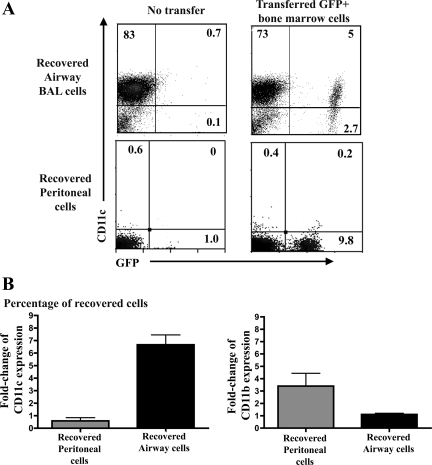Fig. 4.
Effects of airway vs. peritoneal environment on phenotype of bone marrow cells after adoptive transfer into normal mice. Bone marrow cells were collected C57BL/6 mice transgenic for expression of the green fluorescent protein (GFP) gene under control of the ubiquitin promoter (UBI-GFP/BL6), and 1 × 107 cells were transferred into the airways of normal C57BL/6 mice (n = 3–4) by intratracheal injection or into the peritoneum (n = 3–4) by intraperitoneal injection. Airway and peritoneal cells were recovered from transferred mice 7 or 14 days (data not shown for 14 days) later by BAL or peritoneal lavage, immunostained, and analyzed by flow cytometry. A: representative plots of expression of CD11c on GFP+ airway cells in naïve C57BL/6 (top left) and adoptively transferred mice (top right), as assessed by flow cytometry. Expression of CD11c by GFP+ peritoneal cells in naïve C57BL/6 (bottom left) and adoptively transferred mice (bottom right) was assessed by flow cytometry. B: fold change in CD11c and CD11b expression of recovered GFP+ cells in peritoneum and airways of adoptively transferred mice. Percentage of CD11c+ cells was significantly increased in bone marrow cells recovered from airways of transferred mice compared with pretransfer bone marrow (P < 0.05, by t-test). Percentage of CD11b+ cells was significantly increased in bone marrow transferred peritoneum compared with untransferred cells (P < 0.01).

